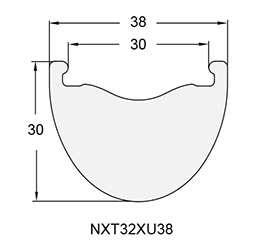Introduction
In May 2021, we developed and produced the world's largest carbon fiber bicycle rim —— Unicorn 36". in response to the needs of some cycling enthusiasts who pursue the extreme size wheels. For us, developing a 36 inch carbon fiber bicycle rim is a new and bold attempt. Since then, our loyal fans have been asking us if we could develop a smaller size carbon rim, namely 32 inches. NEXTIE has always been willing to develop new products that our fans like and want. The development of 32-inch wheel is naturally our duty.
This is the world's first 32-inch carbon fiber bicycle rim —— Unicorn 32". It is developed according to the international standard ISO, the BSD is 686mm. The inner width is 30mm, which can be well suitable for the current mainstream 2.25-inch tires.
The weight of model NXT32XU38 is 530g. The profile drawing of this rim is as below.

This rim could be used for Trail, Enduro and Freeride riding. The tire size for this model of rim is recommended at 2.0" ~ 2.75". The tire pressure is recommended at 30 ~ 60 psi.
Some riders may ask, compared with the current mainstream wheel sizes 26", 27.5" and 29", what is the significance of the existence of these larger-sized wheels? What are the advantages and potential of them? Travis Brown presented his oppions.
Around three years ago, PinkBike once interviewed Trek's Travis Brown, the topic was to study the advantages and disadvantages of 32-inch and 36-inch wheels, and the meaning of existence. Back then there were no carbon fiber 32" and 36" bike rims. Travis customized a large-sized bicycle for testing, using aluminum alloy wheels, researched and tested the different experiences and feelings that large size wheels bring to riding.
After the riding test, Travis elaborated on the different riding experience brought by the larger size. He said that compared with the mainstream 29-inch bicycles, larger-sized wheels can bring higher speed, but because the inertia is relatively large, harder to accelerate. Inertia also has a positive side, it's easier to carry speed through rough terrain than with a smaller wheel because of the characteristic of the contact patch being longer, you're engaging more knobs. So, both climbing and braking traction are better and cornering traction is better.
Here is a link to the interview details: interview-treks-travis-brown-on-experimenting-with-32-and-36-wheels




 General supplier
General supplier









 Facebook
Facebook  Twitter
Twitter  Linkedin
Linkedin  YouTube
YouTube  Blogger
Blogger  Instagram
Instagram 
















